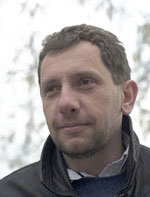Dr. Danko Nikolić
The PhysOrg article Researchers crack part of the neuronal code said
“Prostheses for paralyzed patients, communication with patients who have lost all capacity for normal communication — the hopes for modern brain research are high. However, such brain-machine interfaces (cyborgs) require a complete dictionary, with the help of which the activities of the brain can be translated successfully into desires, ideas and movement plans.Together with colleagues from the Graz University of Technology, scientists from the Max Planck Institute for Brain Research in Frankfurt have succeeded in taking a step towards achieving this. They have shown that early processing stages in the brain gather information over an extended period.
How does the brain store detailed information from sensory stimuli? How much can researchers read from the activity of certain regions of the brain? Current findings confirm a new theory. Up to now, scientists had assumed that the early stages of information processing in the brain took place gradually, that is that one stimulus was processed after another in a conveyor-belt-like sequence. This idea must now be revised.
As Danko Nikolić from the Max Planck Institute for Brain Research and his Austrian colleagues Wolfgang Maass and Stefan Häusler have shown, the activity in early brain areas depends on stimuli that arose some time ago. ‘The brain functions like a jug of water into which stones are thrown and, as a result, generate waves,’ explains Nikolić. ‘The waves overlap but the information as to how many stones were thrown into the jug and when they were thrown in is retained in the resulting complex activity patterns of the fluid.’”
Danko Nikolić, Ph.D. is Researcher at Department of Neurophysiology, Max Planck Institut for Brain Research and Researcher at Frankfurt Institute for Advanced Studies, Wolfgang Goethe University.
His research topics are:
- Temporal coding by relative spiking delays
- Surround modulation in visual cortex and neuronal synchronization
- Relationship between visual attention, visual WM and visual LTM,
- The nature of synaesthesia
- The iconic brain
- Applied scientific epistemology
Danko coauthored The Gamma Cycle, The Role of Oscillations and Synchrony in Cortical Networks and Their Putative Relevance for the Pathophysiology of Schizophrenia, Brightness Induction: Rate Enhancement and Neuronal Synchronization as Complementary Codes, Common neural substrates for visual working memory and attention, A Small World of Neuronal Synchrony, and Spatio-temporal structure in large neuronal networks detected from cross correlation. Read the full list of his publications!
At the University of Zagreb, Croatia, Danko earned both a diploma in Psychology (1994) and a bachelor’s degree in Civil Engineering (1992). His master’s degree (1997) and Ph.D. (1999) was earned at the Department of Psychology, University of Oklahoma, USA.
Read his LinkedIn profile.
